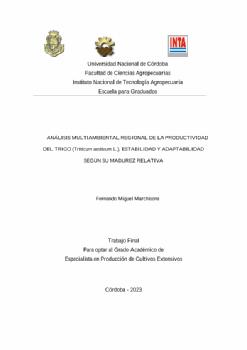| dc.contributor | Rosetti, Lucía | |
| dc.contributor.advisor | Zuil, Sebastián | |
| dc.contributor.author | Marchisone, Fernando Miguel | |
| dc.date.accessioned | 2023-04-27T17:01:02Z | |
| dc.date.available | 2023-04-27T17:01:02Z | |
| dc.date.issued | 2023 | |
| dc.identifier.uri | http://hdl.handle.net/11086/547225 | |
| dc.description | Trabajo Final (Especialización en Producción de Cultivos Extensivos) – UNC- Facultad de Ciencias Agropecuarias, INTA-EEA Manfredi, 2023 | es |
| dc.description.abstract | El rendimiento del cultivo de trigo (Triticum aestivum L.) es el resultado del genotipo, el ambiente y su interacción. En distintas localidades de Argentina se lleva a cabo la Red Nacional de Evaluación de cultivares de Trigo (RET), donde se puede observar el comportamiento productivo para cada genotipo. En este trabajo se analizaron 38 ambientes presentes en la RET distribuidos en las localidades de Reconquista, Rafaela, Oliveros, Marcos Juárez, Venado Tuerto y Pergamino, para evaluar la estabilidad y adaptabilidad de cada grupo de madurez (ciclos) en cada ambiente. Los cultivares se clasificaron según la duración total de su ciclo en largos (CL), intermedios (CI) y cortos (CC). Para analizar estabilidad se siguieron dos metodologías: i) diferencial de rendimiento porcentual (DRTO) versus coeficiente de variación (CV) y ii) rendimiento medio en función del coeficiente Shukla (1972). Para conocer la adaptabilidad se empleó la técnica de regresión, siguiendo la metodología de Finlay y Wilkinson (1963). Se observó que los cultivares de CL fueron los que presentaron mayor rendimiento, pero no alcanzaron la estabilidad de los CI, mientras que los CC presentaron menor estabilidad y rendimiento. Las localidades más productivas fueron Marcos Juárez y Pergamino y la menos productiva fue Oliveros. Todos los ciclos presentaron alta adaptabilidad al ambiente. Se analizó el impacto de las variables ambientales mediante un análisis de componentes principales, donde se observó que las precipitaciones acumuladas fue la variable de mayor importancia a nivel de subregión, mientras que al analizarlo por localidad la más significativa fue la temperatura media. | es |
| dc.description.abstract | The yield of wheat (Triticum aestivum L.) is the result of genotype, environment and their interaction. In different sites of Argentina, the National Wheat Cultivar Evaluation Network (RET) is carried out, where the productive behavior for each genotype can be observed. In this work, 38 environments distributed in the sites of Reconquista, Rafaela, Oliveros, Marcos Juárez, Venado Tuerto and Pergamino, were analysed to evaluate the stability and adaptability of each maturity group (cycles) to each environment. The cultivars were classified according to the total duration of their cycle in long (CL), intermediate (CI) and short (CC). To analyse stability, two methodologies were followed: i) percentage yield differential (DRTO) versus coefficient of variation (CV) and ii) mean yield based on the Shukla coefficient (1972). To estimate the adaptability, regressions were carried out, following the methodology of Finlay and Wilkinson (1963). It was observed that the CL cultivars were the ones that achieved the highest yield but they did not reach the stability that those of CI. The CC genotypes had the lowest stability as well as yield. The most productive localities were Marcos Juárez and Pergamino while the least one was Oliveros. All cycles presented high adaptability to the environment. The impact of the environmental variables on yield was also analysed through a principal components analysis, where it was observed that the accumulated rainfall was the most important variable at the subregion level, while when analysing it by locality, the most significant was the average temperature. | en |
| dc.format.extent | 44 p. : tablas, gráficos | es |
| dc.language.iso | spa | es |
| dc.rights | Attribution-NonCommercial-NoDerivatives 4.0 Internacional | * |
| dc.rights.uri | http://creativecommons.org/licenses/by-nc-nd/4.0/ | * |
| dc.subject | Trigo | es |
| dc.subject | Interacción genotipo ambiente | es |
| dc.subject | Rendimiento de cultivos | es |
| dc.subject | Adaptación | es |
| dc.subject | Argentina | es |
| dc.title | Análisis multiambiental regional de la productividad del trigo (Triticum aestivum L.), estabilidad y adaptabilidad según su madurez relativa | es |
| dc.type | masterThesis | es |
| dc.description.fil | Fil: Marchisone, Fernando Miguel. Universidad Nacional de Córdoba. Facultad de Ciencias Agropecuarias; Argentina. | es |
| dc.description.fil | Fil: Zuil, Sebastián. Instituto Nacional de Tecnología Agropecuaria (INTA). Estación Experimental Agropecuaria Rafaela; Argentina. | es |
| dc.description.fil | Fil: Rosetti, Lucía. Instituto Nacional de Tecnología Agropecuaria (INTA). Estación Experimental Agropecuaria Rafaela; Argentina. | es |





